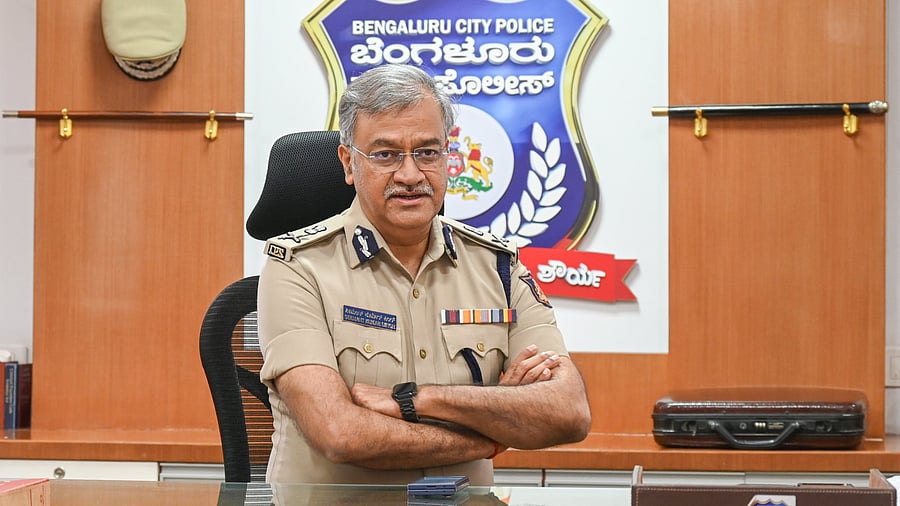
Seemant Kumar Singh, Bengaluru City Police Commissioner.
Credit: DH PHOTO/SK DINESH
Maintaining law and order in a city like Bengaluru is a challenging task.
With 11 people killed in a stampede at the Chinnaswamy Stadium and a clutch of high-ranking police officials, including the Bengaluru city police commissioner, suspended over the tragedy, stepping into the shoes of the city’s top cop could be unenviable.
But IPS officer Seemant Kumar Singh, who replaced the previous police commissioner, is undaunted by the occasion.
In an interview with DH, Singh detailed his plans to implement people-centric policing measures, break the nexus between the police and the land mafia, ensure a safer Bengaluru for women, and leverage technology to curtail criminals and criminal activities in the city.
Excerpts:
How do you plan to crack down on the alleged links between the real estate lobby, land mafia and police?
I have made it clear that police stations should stay away from civil disputes. We have been maintaining records regarding administrative work, including which officers have dealt with what cases, how they were solved, and the time taken to crack them. We will also identify touts and brokers who work in connivance with the police, real estate, and land mafia, and break the nexus.
What measures are afoot to ease traffic congestion in the city?
Effective enforcement, regulation, and strategic deputation of traffic police personnel is key to smooth traffic management.
The Bangalore Development Authority (BDA), Bruhat Bengaluru Mahanagara Palike (BBMP), Education Department, and the Regional Transport Offices in the city have been roped in to work with the Bengaluru Traffic Police to ease traffic issues.
For instance, we have asked RTOs to book cases against erring drivers and jointly help in enforcement. The BBMP has been instructed to remove all kinds of illegal parking on major stretches like the Outer Ring Road. Each of the four traffic divisions in the city has been assigned one or two engineers, who will inspect roads needing immediate attention and carry out repair work on priority. These small but significant changes will have a huge impact on the common man.
What plans do you have to make Bengaluru a safer place for women?
There are different safety measures under the Safe City Project such as the Suraksha app, foot patrolling, safety islands, 112 helpline, and police personnel equipped with body-worn cameras. But women must be sensitised about the existence of these measures.
I have asked women DCPs to work with all police staff, right down to the constable level, to sensitise the public, especially women, about how they can reach the police. I have proposed that, on a regular basis, public from all walks of life must be brought to the command centre to show them how we function — what goes on in the control room, how police respond to public calls for help, and how cases are dealt with and disposed of.
About 25% of the Bengaluru City Police force comprises women personnel. I want to propose that only women personnel do night rounds on one day. I also want to document all cases reported at jurisdictional police stations, regularly review them, and follow up. This will give us an idea of the flow and help us depute police personnel accordingly.
What are your plans to further upgrade the involvement of technology in improving the police-public interface?
The crime and social media wings of the city police work in isolation. I have proposed that DCPs and related teams work together on all matters related to intelligence, crime, and social media monitoring. While closely and carefully monitoring social media, I have instructed our staff to counter fake news and hate speech as required and address those who create issues through their posts.
The criminal tracking systems we have in place help identify professional criminals, track them, and categorise crimes. This is a part of basic policing. But we also stay a step ahead by monitoring a criminal even after release from jail — checking if they have served their term and tracking their activities.
Rowdyism and drug menace continue to thrive in Bengaluru…
The rowdy monitoring cell needs to be given more teeth to keep a tab on old rowdies and budding ones. We maintain a record and regularly check their source of income, what vehicles they use and where they got them from, who funds them, and for what purposes.
I believe if day-to-day policing is strong, all other things will fall into place. The Central Crime Branch and Narcotics Control Bureau are working closely to break the drug mafia in the city and penetrate their network.